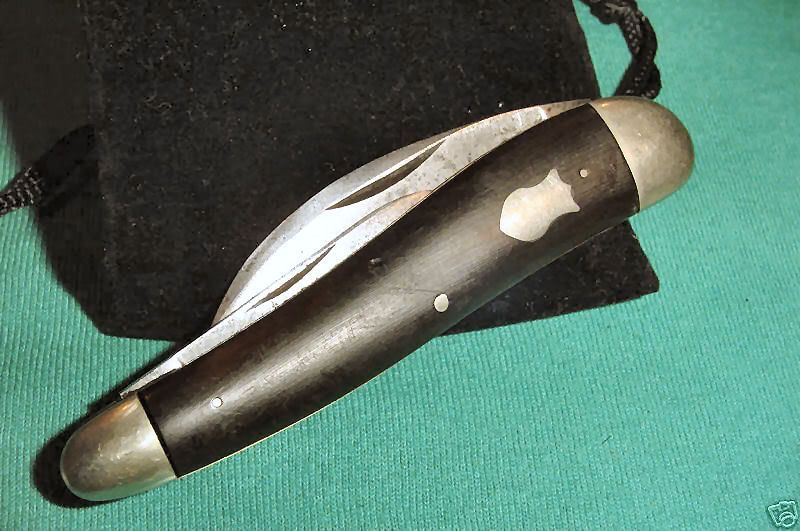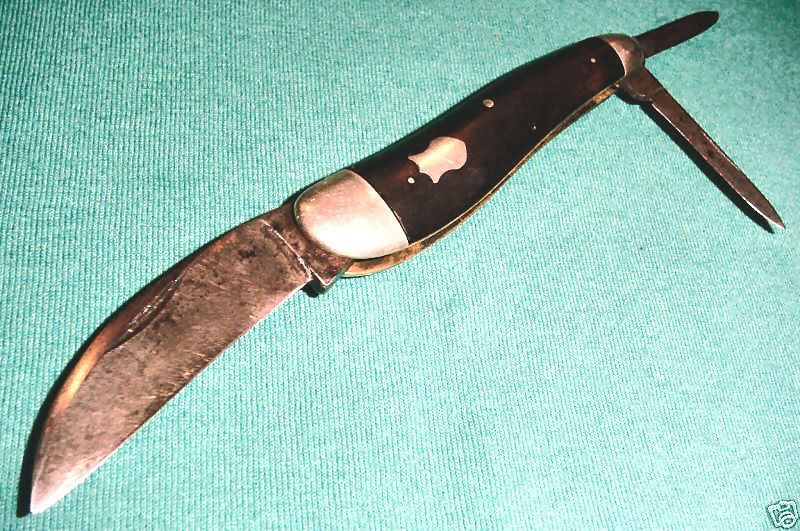iKnife Collector
The online community of knife collectors, A Knife Family Forged in Steel
SHOULD I POLISH BLADES OF OLD KNIVES?
I just polished the blades on an old, cheap Boker knife. I have a polishing wheel that I've used for years to polish brass and copper, so I'm experienced at using the wheel. But, being new to knife collecting, I'm wondering if I'd be making a mistake by polishing blades of better knives. It doesn't remove pits, but it removes all the spots and makes the blades shine.
Will appreciate any advise.
Will appreciate any advise.
Tags:
Replies to This Discussion
-
Permalink Reply by Roger Cunningham on June 16, 2009 at 8:06
-
In most cases NO.If it is an old knife with good blades,a little tarnish,pits,even some lite rust is expected.Old knives aren`t new and they shouldn`t shine like it. Personally I don`t have a problem cleaning up the active rust with semichrome or something like it.
-
Permalink Reply by Frank Plant on June 18, 2009 at 0:05
-
Thanks, Roger. Makes sense to me. And, I love Semichrome polish.
Frank
-
Permalink Reply by J.J. Smith III on June 18, 2009 at 0:38
-
I intentionally turned the blades on this Bulldog Whittler, so I could control the amount of "Color" that it took on. I have an older Schrade that is almost black, but still sharp as a razor. I actually think that a certain amount of tarnish actually protects the steel, as lonk as there is no pitting and surface rust.
-
Permalink Reply by DELBERT COVER on June 18, 2009 at 9:38
-
i wouldnt touch the blemish on this knife for anything. there must have been some impurities in the metal from the start and finally showed up years after.
- Attachments:
-
-
 MVC-012S.JPG, 23 KB
MVC-012S.JPG, 23 KB
-
-
Permalink Reply by Trent Rock on June 27, 2009 at 1:13
-
I like my knives with character....
-
In MemoriamPermalink Reply by Scott King on June 27, 2009 at 10:03 -
To me it's like a person having plastic surgery on their face. The person and the character of his face is never the same.
-
Permalink Reply by Jim Prather on July 5, 2009 at 17:36
-
I would never touch an antique knife unless it is factory mint. If it is mint, with no blemishes, I would continue to keep it mint with Renaissance Pre-Lim, and then a protective coating of Renaissance Wax. As far as my antiques are concerned, I always preserve the tatina with Renaissance Wax and a light hand buff. This arrests any further corrosion and preserves the history of the knife.
You can bet that this old, and VERY RARE, Holley Wharncliffe had a patina on it when I was lucky enough to acquire it, but it has no rust, and it never will! I didn't even polish the shiels and bolsters.
Holley was the first full time manufacturer of pocket knives in the United States.


And neither will this ever rust! Just got it in the mail from Michael Hoover at:
http://redrummdknives.blademakers.com/
The material is "Dinousaur Gem Bone". Michael is the only person I know of who does this. - Attachments:
-
-
 2009_06300026a.jpg, 142 KB
2009_06300026a.jpg, 142 KB -
 2009_06300036a.jpg, 152 KB
2009_06300036a.jpg, 152 KB
-
-
Permalink Reply by Kurt Shanor on July 14, 2009 at 0:10
-
I have heard that using a pencil lead on active rust spots will remove and loosen them, but this will show any pitting under the rust. Letting non stainless steel blades patina helps protect the blade from rusting .
-
Permalink Reply by Halicon on November 21, 2009 at 5:24
-
Never ever take an old blade to a polishing wheel. That's probably true for new ones too.
Get yourself a set of good whetstones and go that way. Zero damage to the blade and the pits are long gone.
J.J Smith, what you are referrring to is a healthy patina that forms over repeated courses of oiling the blade and to some extent, positive oxidized steel. That also means that if there were a pit, the oxidization process would be able to reach the "good" steel and thus begin the real rusting process, that's where the blade takes actual damage.
But judging by your picture, that knife has a VERY good patina on it, you can probably dunk it in an acid bath and it would still protect it. Good job on achieving that patina!
edit: Why do you people like your knives with "character"? I.e pitting and ugly spots. In my eyes a pit is a broken blade in the making, as the oxidation process will eventually reach it and travel down the steel.
I say get rid of all the pits and make a perfect smooth surface, and only then you can oil it in regularly and thus create a new patina for that aged look.
-
Permalink Reply by Jim Prather on November 21, 2009 at 15:30
-
"Get yourself a set of good whetstones and go that way. Zero damage to the blade and the pits are long gone."
You can NOT be serious! Can you imagine what would happen to the value of my Holley Wharncliffe Whittler, above, if I did as you suggest? And "dunk it in acid"? Where was your mother when you wrote that?
I simply can't believe any serious collector would take a piece of history and either put it on a polishing wheel, or take a whet rock, or acid to it. That would TOTALLY destroy the value to a piece of Americana. This is NOT an antique car we're talking about! I have BOUGHT cars for less than I paid for this particular knife!
"Why do you people like your knives with "character"? I.e pitting and ugly spots. In my eyes a pit is a broken blade in the making, as the oxidation process will eventually reach it and travel down the steel."
If a pit leads to a broken blade, that only means that the owner is using it. If that is the case, that tells me that they are just buying old knives to clean up and use. Why not just buy a new knife and use it until it falls apart? That's not what a collector does. And, I think Roger Cunningham is spot on with his comment: "Old knives aren't new and they shouldn't shine like it."
Sorry if my opinion disagrees with any other opinion on this forum, but polishing the pits out of an antique knife with a whet stone is just a little radical, to me. It shows me that one would want it for a user, not a collectable. And that's fine. But that's no longer a collectable knife in my opinion. At least not in my collection. And mine is quite extensive with some VERY sought after, historical items in it.
I have made many knives out of non-stainless steels. Over the years, they gain a patina to them with use. Some people have purchased my knives for the purpose of a collectable. They asked me how to preserve it's finish with the idea that it will never be used. I ALWAYS recommend Renaissance Museum Wax. It is a microcrystaline wax that will protect the finish. But I would NEVER recommend the REMOVAL of metal to make the knife look better. And how in the world would one use the whet stone technique on a hollow ground knife?
Sorry about the rant. But I hope I'm in time to stop some of you new collectors from removing metal to make an old knife look like a new one. If you want a new knife look, buy a new knife!
LTA, Uncle Jim
-
Permalink Reply by Halicon on November 21, 2009 at 18:32
-
Pardon me but I believe you mistook my earlier post entirely. What my text says is that one 'could' do it with no damage. I have a good amount of knowledge and respect -myself- to never do such a thing, but apparantly some people does it to theirs - something you can prevent with a good polish on whestones.
I finish the finest of cutlery, even worth up to thousands with traditional Japanese methods on a natural stone with water as lubricant, that is not a mistreatment and I actually take offence to that sentence as I have spent almost a decade to learn the proper techniques.
The removal of metal happens whether you want it or not. Every cut you place will damage the edge a bit microscopically, and having a highly finished edge will lesser the damage to the edge which in addition adds longevity.
How would you restore a rusted knife? I do it with gradually finer whetstones, by hand under careful inspection by the techniques I was taught. These do include hollow ground blades, for gods sake most straight razors are hollow ground and whetstones are among the most popular of sharpening methods for that.
I work days, even weeks daily on a traditionally forged Japanese blade and you say this is destroying historical items? I have to say that I'm really keeping my feelings in right now...
-
Permalink Reply by Jim Prather on November 21, 2009 at 23:35
-
Well... I'm glad you're keeping your feelings in. Because it seemed that you were suggesting using a whet stone to refurbish, or polish an antique pocket knife. I don't know about straight razors, they were never mentioned, but I DO know that a serious collector of pocket knives, and probably hunting knives, as well, would NEVER touch an antique blade, or blade of historical significance, to a polishing wheel, much less a whet stone. How many people reading this forum do you think would have the training that you have with a Japanese Stone? Well, isn't that what you were advocating? It's clear now, that you didn't mean just ANYbody could do this. But a tradesman, or someone who is trained in the use of a true stone and not a piece of rock that one would pick up at WalMart.
Crackie! Can you imagine someone having a genuine James Black Bowie knife, and someone else comes along and says, "Hey, that thing sure is pitted. Let me put that on my whitrock and get it all shined up for ya'! I bet I can even get that thar blood off of it"?!
OK... So we're straight, now.
DO NOT use a stone, acid, a buffing wheel, or any other metal removing device or acidic chemical to make a collectible knife shiny! Unless you are going to use it! That's what the topic is about.
Oh... and if you want some really fine stones, hand made in the Japanese tradition, check this out:
http://www.tcblades.com/natural_whetstones
P.S.
"I finish the finest of cutlery, even worth up to thousands with traditional Japanese methods on a natural stone with water as lubricant, that is not a mistreatment and I actually take offence to that sentence as I have spent almost a decade to learn the proper techniques."
I'm terribly sorry that you took offense at a statement about "mistreatment". I couldn't find said statement. But I'm sorry if you were offended, in any event.
This is a forum, and by definition, there are bound to be disagreements. I don't think our's is necessarilly a disagreement, but rather, a misunderstanding. For my part, I apologize.
White River Knives
Latest Activity
KnifeMakerAlexander Åhl posted a status
"Thank you for the warm welcome. Looks like the perfect place for me!"
yesterday
2024 Solvang Custom Knife Show at Hotel Corque
April 26, 2024 to April 27, 2024
Apr 12
Visit Lee' s Cutlery
KNIFE AUCTIONS
KNIFE MAGAZINE!!!
JSR Sports!
Click to visit
© 2024 Created by Jan Carter.
Powered by
![]()